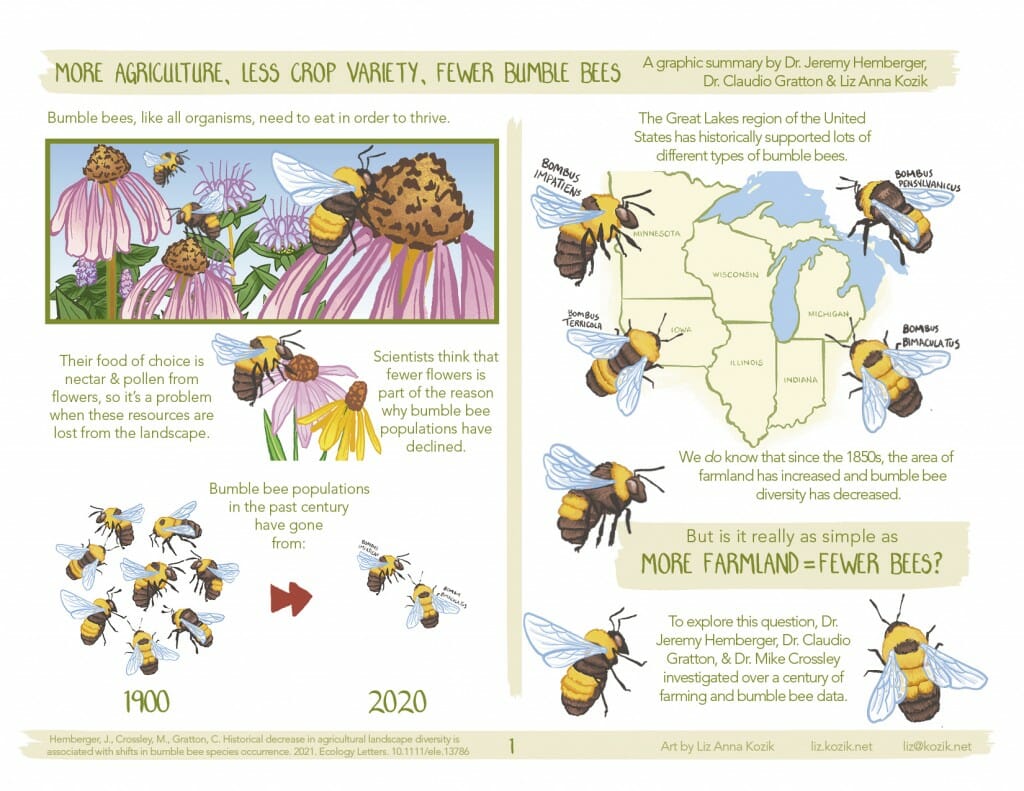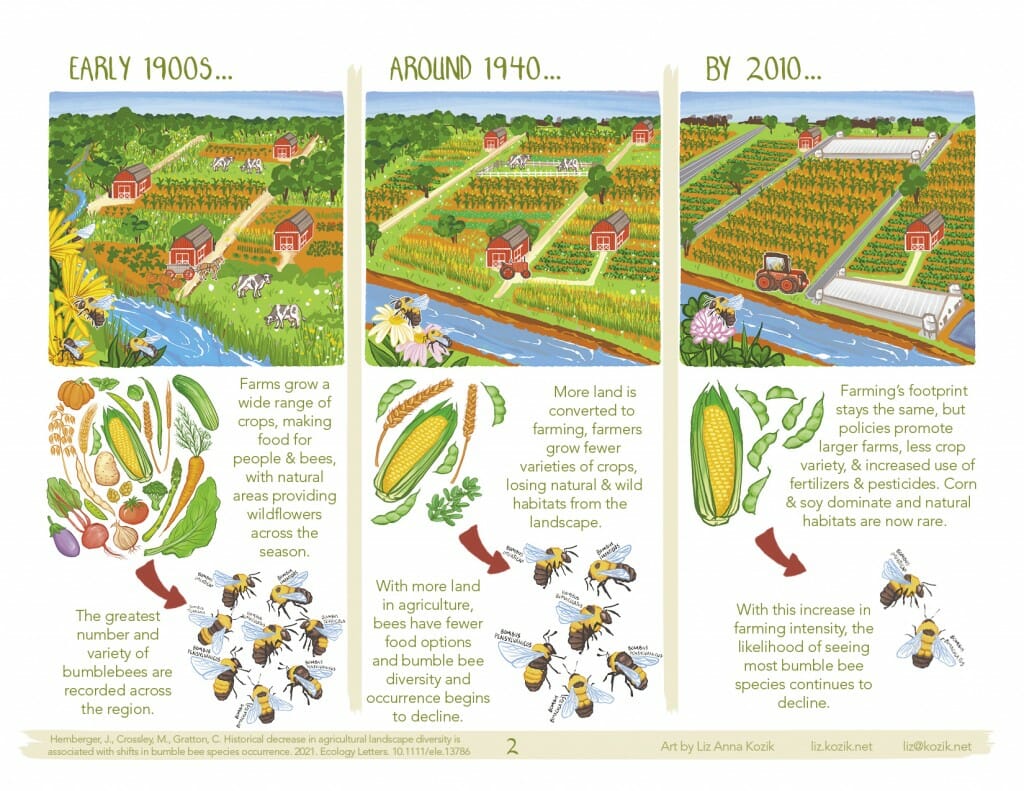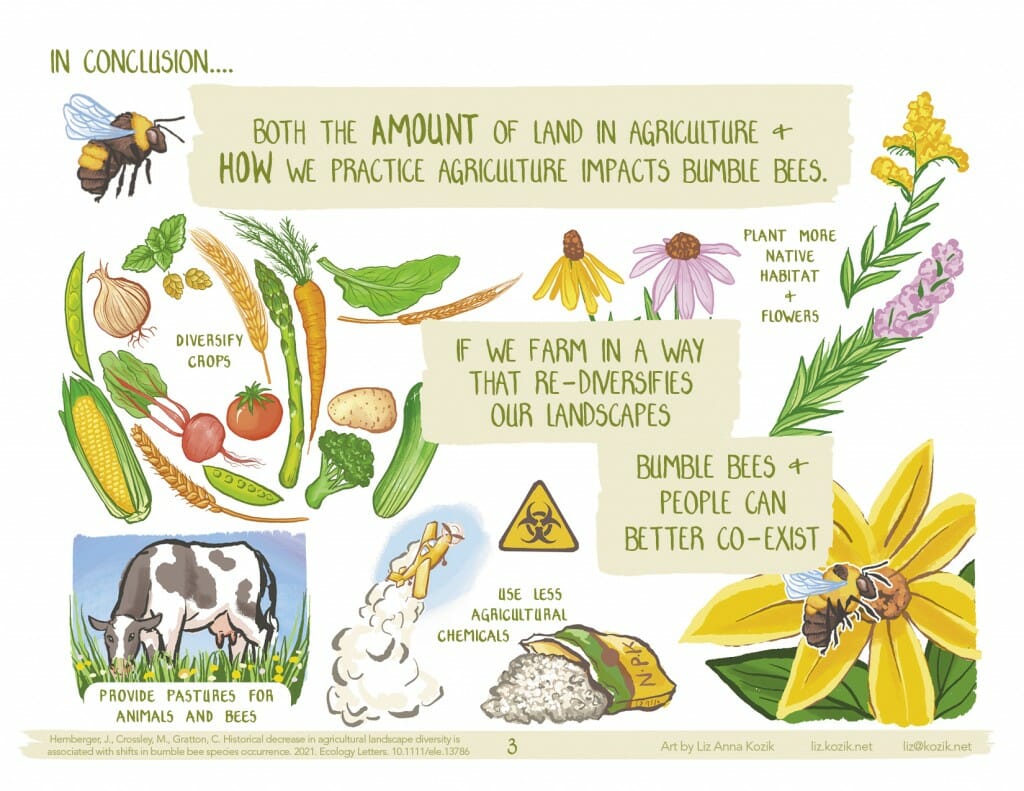Madison, Wisconsin, USA
June 22, 2021

As farmers cultivated more land and began to grow fewer types of crops over the last 150 years, most native bumble bee species became rarer in Midwestern states.
New research reveals that these species declined while the average number of different crops grown in these states was cut in half and as modern agriculture began to focus on intensive production of corn and soybeans. A handful of hardy species continue to thrive today, but they also seem to prefer areas with a more diverse assortment of crops such as hay, beans, potatoes and oats in addition to corn and soy.
The findings suggest that landscapes with a wider range of crops could support more bumble bees, which are vital pollinators for both native plants and many crops.
“This study shows that there’s a lot of opportunity to support biodiversity by adjusting farming practices,” says Jeremy Hemberger, an author of the report who completed the work while a graduate student at the University of Wisconsin–Madison.
The researchers suspect that a decrease in the number and variety of flowers — the bees’ only food source — on both farmland and on nearby uncultivated land is the best explanation for why some species have become more common while most have become rarer. Other factors that correlate with these large-scale, long-term changes, such as the use of pesticides, may play a role as well.

Hemberger, UW–Madison Professor of Entomology Claudio Gratton and University of Georgia postdoctoral researcher Michael Crossley published their findings June 18 in the journal Ecology Letters.
The researchers relied on two sources of bumble bee records that tracked when and where different species were spotted. The Global Biodiversity Information Facility has records extending back to the 19th century, largely from natural history collections. For the most recent data, the team turned to Bumble Bee Watch, a citizen-science project where user-submitted bee identifications are verified by experts.
Agricultural records came from a previous study by Crossley, who analyzed national data on the number of crops grown and the percentage of cultivated land across the contiguous U.S. The current study focused on Minnesota, Iowa, Wisconsin, Illinois, Michigan and Indiana.
Using these historical datasets, the team modeled the rise and fall of 13 native bumble bee species and how these changes correlated with agricultural practices in 535 counties in these six states. Of those 13 species, seven are less common today than they were 130 years ago. Over that span, the extent of cropland increased modestly. But the biggest change was a drop in the average number of crops grown per county from 12 to six.
The remaining bee species showed either little change in occurrence or an increase over time.
“There are some species that seem to be more resilient to what we’ve created in the landscape right now,” says Hemberger, now a U.S. Department of Agriculture postdoctoral fellow at the University of California, Davis. “The ones that are doing well, they’re generalists. They feed on a lot of different plant species, especially those associated with agriculture like common weedy flowers.”
Even these generalist species tended to be more common in counties that cultivated a wider range of crops.
Many factors influenced the move to more intensive cultivation of fewer crops, including federal policies, changing diets and industrialization.
“The policies that we’ve put into place that have focused on increasing crop production have also pushed consolidation and have made our systems really sensitive and fragile when it comes to maintaining those organisms that we actually depend on to sustain our agriculture,” says Gratton. “In our effort to be more efficient in agriculture, we’ve made ourselves less resilient. And we’ve had to substitute that with costly interventions,” like importing bees to support pollination.
The trend toward growing fewer crops correlates with many other changes to agricultural practices. Pesticide and fertilizer use, farm size, the development of genetically modified crops, tilling practices, and many other factors have changed significantly over the last 150 years.
These correlated changes make it difficult to determine the precise cause behind the bee declines, although the diversity and abundance of flowers in the landscape is most likely the dominant contributing factor. Going forward, the researchers want to more closely examine individual bumble bee species to identify the mechanisms behind the decline in these important pollinators.

This work was supported in part by the U.S. Department of Agriculture (grants 2019-68012-29852, 2019-67013-29298 and Hatch WIS01988).